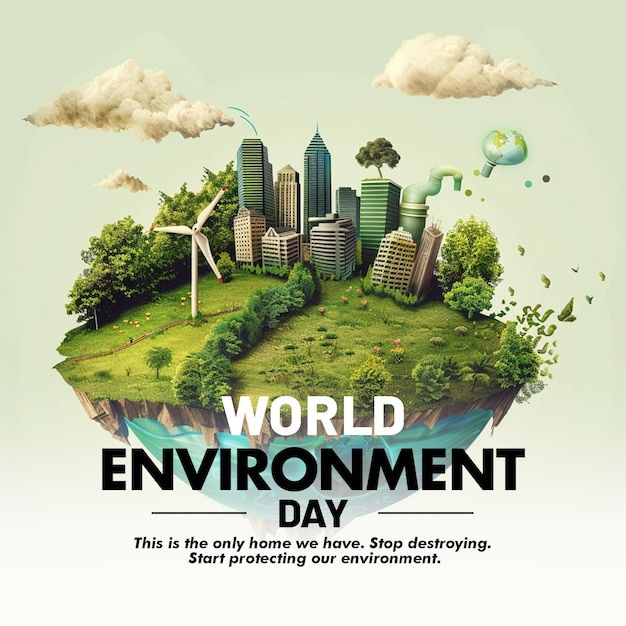World Environment Day: A Global Call for Action to Protect Our Planet
Introduction
World Environment Day is celebrated every year on June 5th and serves as a reminder of the importance of environmental conservation for the well-being of our planet. Established by the United Nations in 1972 during the Stockholm Conference on the Human Environment, it aims to raise awareness about environmental issues and encourage people to take action to protect the Earth. The theme for each year focuses on specific environmental challenges, whether related to climate change, pollution, or biodiversity.
As climate change, pollution, and other environmental crises become more urgent, World Environment Day plays an essential role in uniting people, governments, and organizations worldwide to work towards a sustainable future. It’s not just a day of reflection, but one of action and global solidarity.
History
It was first held in 1974 under the theme “Only One Earth,” emphasizing the shared responsibility of nations to protect the environment. This day was created to bring attention to environmental issues and promote action at all levels of society.
Over the years, World Environment Day has gained significant traction, becoming the largest global environmental observance. Since its inception, it has highlighted different environmental challenges, including climate change, biodiversity loss, and pollution, inspiring actions from individuals and governments worldwide.
In 2012, the United Nations decided that the host country for World Environment Day would rotate annually, and different nations host the event each year. This approach brings diverse perspectives and solutions to global environmental challenges.
Facts
- A Global Movement: It is celebrated by millions of people across more than 150 countries around the world. It brings together governments, organizations, celebrities, and individuals to raise awareness and promote environmental protection.
- Annual Themes: Each year, the United Nations chooses a theme for World Environment Day, addressing pressing environmental issues. These themes often inspire local and global campaigns, initiatives, and policy discussions.
- Youth and Education: Young people are often at the forefront of World Environment Day celebrations. Educational institutions host events, art exhibitions, and workshops to inspire future generations to engage in environmental conservation.
- Encouraging Sustainable Practices: The goal of World Environment Day is not just to raise awareness but also to encourage individuals to take practical steps towards a more sustainable lifestyle, such as reducing waste, conserving water, and supporting eco-friendly products.
- A Chance for Advocacy: World Environment Day provides a platform for environmental organizations to promote their causes and push for policy changes. It’s a day when voices advocating for stronger environmental laws and regulations are amplified.
Significance
- Raising Awareness About Environmental Issues: The core purpose of World Environment Day is to educate people about the challenges facing our environment, including issues like climate change, deforestation, and pollution. Understanding the scale of these challenges is essential for inspiring collective action.
- Inspiring Collective Action: While individual efforts are important, the day emphasizes that significant change requires a collective effort. Whether it’s planting trees, reducing plastic waste, or supporting green policies, every action counts towards a healthier planet.
- Promoting Sustainability: World Environment Day encourages individuals, communities, and businesses to adopt sustainable practices. This includes reducing energy consumption, using renewable resources, recycling, and promoting eco-friendly products and services.
- Combating Climate Change: Climate change is one of the most pressing issues of our time. World Environment Day serves as a reminder of the importance of addressing climate change by reducing carbon emissions, protecting forests, and transitioning to renewable energy sources.
- Protecting Biodiversity: With many species on the brink of extinction, World Environment Day highlights the importance of preserving biodiversity. Protecting ecosystems and wildlife is essential for maintaining the balance of nature and ensuring future generations can enjoy a rich and diverse environment.
Daily Life Impacts
The impacts of World Environment Day extend far beyond the observance of a single day. The awareness and actions encouraged on this day ripple out into everyday life. Here’s how it influences our daily lives:
- Reduced Pollution: With increased focus on the harmful effects of pollution, individuals and organizations are encouraged to adopt eco-friendly practices. Recycling, using less plastic, and reducing waste are some everyday actions that contribute to a cleaner environment.
- Encouraging Green Technologies: The adoption of renewable energy, electric vehicles, and sustainable farming practices is gaining momentum. World Environment Day highlights the importance of investing in green technologies, which leads to a cleaner, more sustainable future.
- Fostering Conservation Habits: World Environment Day reminds us of the need to conserve resources. From turning off lights when not in use to reducing water waste, these simple daily actions can have a big impact on the environment.
- Supporting Local Initiatives: Many local communities organize tree-planting events, beach cleanups, or environmental awareness campaigns on World Environment Day. This fosters a sense of community involvement and personal responsibility in safeguarding the environment.
- Promoting Eco-Friendly Products: Awareness raised on this day encourages people to support products that are sustainably sourced and produced. Whether it’s choosing eco-friendly cleaning supplies or supporting companies with sustainable practices, individuals can make a significant impact with their purchasing decisions.
FAQs
1. What is the main goal of World Environment Day?
The main goal of World Environment Day is to raise global awareness about environmental issues and encourage people to take action to protect and preserve the environment for future generations.
2. How can I participate in World Environment Day?
You can participate by attending local events, organizing cleanups, spreading awareness through social media, or adopting more sustainable practices in your daily life.
3. What are some past themes of World Environment Day?
Past themes have included “Beat Plastic Pollution,” “Time for Nature,” and “Biodiversity.” Each theme highlights a different environmental challenge that requires immediate attention.
4. Why is it important to observe World Environment Day?
Observing World Environment Day helps to highlight the critical issues our planet faces, and it serves as a reminder that collective action is necessary to protect our planet and its resources.
5. How can World Environment Day contribute to policy change?
The day serves as an advocacy platform for environmental organizations and governments to push for stronger environmental policies and laws aimed at protecting the environment and combating climate change.
Conclusion
It is much more than a single day of celebration—it’s a global call to action. The significance of this observance goes far beyond raising awareness; it inspires people to take tangible steps in their daily lives to protect the environment and contribute to a sustainable future.
By promoting sustainable practices, combating climate change, and protecting biodiversity, we can all play a role in preserving the planet for future generations. World Environment Day is a reminder that every action counts, and together, we can make a lasting difference.
Let’s come together every June 5th to protect our environment—because the future of our planet depends on the choices we make today.










